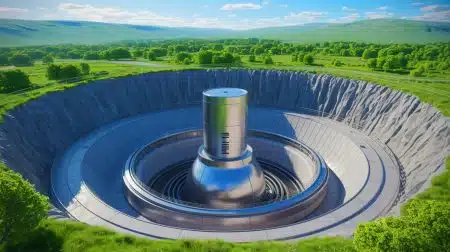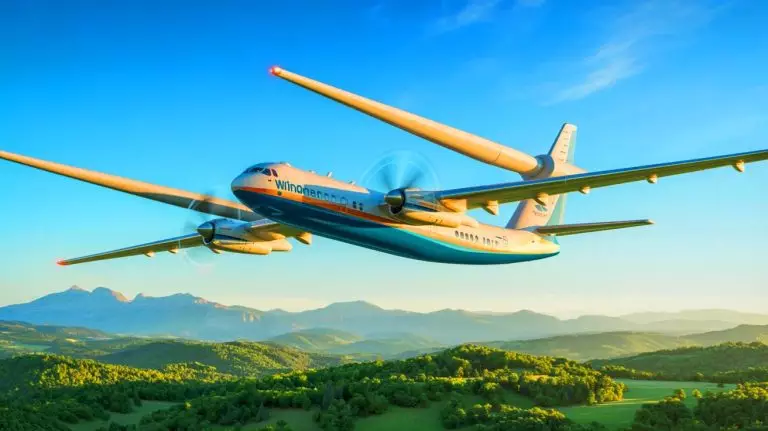| IN A NUTSHELL |
|
The aviation industry is abuzz with excitement as the WindRunner, an ambitious project by Radia, takes flight. This colossal cargo plane is engineered to revolutionize the transportation of large-scale land wind turbines. By overcoming current logistical barriers, the WindRunner promises to transform how we harness wind energy, enabling access to previously unreachable sites. With its impressive dimensions and unmatched carrying capacity, this aircraft is more than just a logistical tool; it marks a significant turning point in the global energy transition, offering new opportunities to accelerate the production of renewable energy.
A Solution to Wind Energy’s Logistical Challenges
Land-based wind energy is a crucial component of the energy transition, yet it faces a significant challenge: transporting its enormous components. Modern wind turbine blades can reach lengths of 230 feet, making their transportation by road or rail complex and costly. This is where the WindRunner comes into play. Designed to transport massive structures directly to production sites, even in the most remote areas, this aircraft allows for a more flexible and rapid installation of wind farms.
With its colossal dimensions, the WindRunner redefines air transport capabilities. By expanding the possibilities for wind turbine location, it actively contributes to enhancing their energy efficiency and reducing carbon emissions. This logistical innovation could very well transform the future of renewable energy, making previously untapped sites accessible.
Radia: A Leader in Aeronautical Innovation
Since its establishment in 2016 by Mark Lundstrom, Radia has become a key player in aeronautical innovation. By developing the WindRunner, the company demonstrates a profound understanding of the challenges of the energy transition. By tackling logistical barriers, Radia offers a viable and innovative solution to accelerate the adoption of renewable energies.
Beyond technical ingenuity, Radia’s success is built on strategic partnerships and solid financial backing. With nearly $110 million raised, the company has attracted renowned investors and partners, such as LS Power and ConocoPhillips. These collaborations ensure the project’s feasibility and strengthen Radia’s position as a leader in the green aviation sector.
The Technical Specifics of the WindRunner
The WindRunner stands out due to its exceptional technical characteristics, designed to meet the specific needs of land wind turbine transportation. With a fuselage length of 354 feet and a volumetric load capacity of approximately 290,000 cubic feet, it surpasses traditional cargo planes. Capable of operating on runways as short as 5,900 feet, it can access remote areas that are otherwise unreachable by other freight aircraft.
This technical innovation is the result of meticulous design that combines robustness with flexibility. By facilitating the transport of large-scale wind turbines, the WindRunner helps optimize their energy efficiency, a major asset in the fight against climate change. It also opens new avenues for the expansion of land wind infrastructure.
A Major Impact on the Global Energy Transition
The WindRunner emerges at a crucial moment for the global energy transition. By facilitating the installation of wind turbines in remote areas, it plays a key role in optimizing wind resources and reducing carbon emissions. According to the International Energy Agency, land wind energy could account for up to 40% of global energy production by 2050. The WindRunner could be an essential catalyst in achieving this goal.
By making wind energy more accessible and efficient, the WindRunner significantly contributes to the decarbonization of the energy sector. It represents a major advancement in the fight against climate change, offering a pragmatic and innovative solution to current energy challenges.
The WindRunner, with its colossal dimensions and impressive capabilities, not only redefines air transport standards but also opens new prospects for the future of land wind energy. By facilitating the transport and installation of large-scale wind turbines, this aircraft helps make wind energy more accessible and efficient, playing a crucial role in the global energy transition. As the world shifts towards a more sustainable economy, what other groundbreaking innovations might emerge to support this movement?
Did you like it? 4.4/5 (29)






Wow, this is like the Transformers of airplanes! Can’t wait to see it in action. 🚀
This could be a game-changer for remote areas with high wind potential. Exciting!
Does Radia plan to build more of these planes, or is it a one-off?
Is this whole website AI? 🤣 Not bad
How soon can we expect the WindRunner to start operations?
This plane sounds like a marvel of engineering. Kudos to Radia! 👏
The size comparison to Airbus A320s really puts things in perspective!
How does WindRunner handle adverse weather conditions? 🤔
Isn’t this just a temporary solution until we find better ways to produce wind energy?
I’d love to see a documentary on the making of this giant plane!
Can it transport anything other than wind turbines? 🚛
What is the lifespan of the WindRunner, given its enormous size and capacity?
This is a remarkable step forward in the fight against climate change. 🌍
How many crew members are needed to operate the WindRunner?
I’m skeptical. Can such a large aircraft truly be more efficient? 🤨
Is the WindRunner already in production, or is it still in the prototype phase?
What’s next for Radia after this? More giant planes or something else?
Isn’t it risky to transport such massive turbines by air? What about safety concerns?
Is this the future of cargo transport? Excited to see where it leads! 🚢✈️
How will the WindRunner’s emissions compare to other transport methods?
Imagine the view from the cockpit of such a massive plane! 🛫
Are there any plans to make the WindRunner autonomous in the future?
This could really help areas with limited infrastructure. Fantastic idea!
It’s amazing how far we’ve come with green energy solutions. Thanks for sharing! 😊
How does the WindRunner handle maintenance and repairs given its size?
The future of energy and aviation looks bright with innovations like these! 🌟
How does this plane affect the local wildlife when it lands in remote areas?
What inspired the design of the WindRunner? It sounds like something out of a sci-fi movie!
Is the WindRunner adaptable for other types of renewable energy equipment?
Hope to see more companies taking such bold steps in green technology!
Thank you for this incredible insight into green energy innovation. Truly inspiring!
How does the WindRunner compare in fuel efficiency to other cargo planes?
Just three A320s? I was expecting something more like a flying city! 😂
Wouldn’t it be more cost-effective to transport parts by sea?
Gr8 article! But what about the environmental impact of such a large plane?
I wonder how much noise this beast makes when it takes off. Hope it’s not too loud!
Even the comment field is populated by AI. Obviously humans has nothing to fear. Dumb af.
There are actual renderings of this aircraft so why use such a poor AI image?